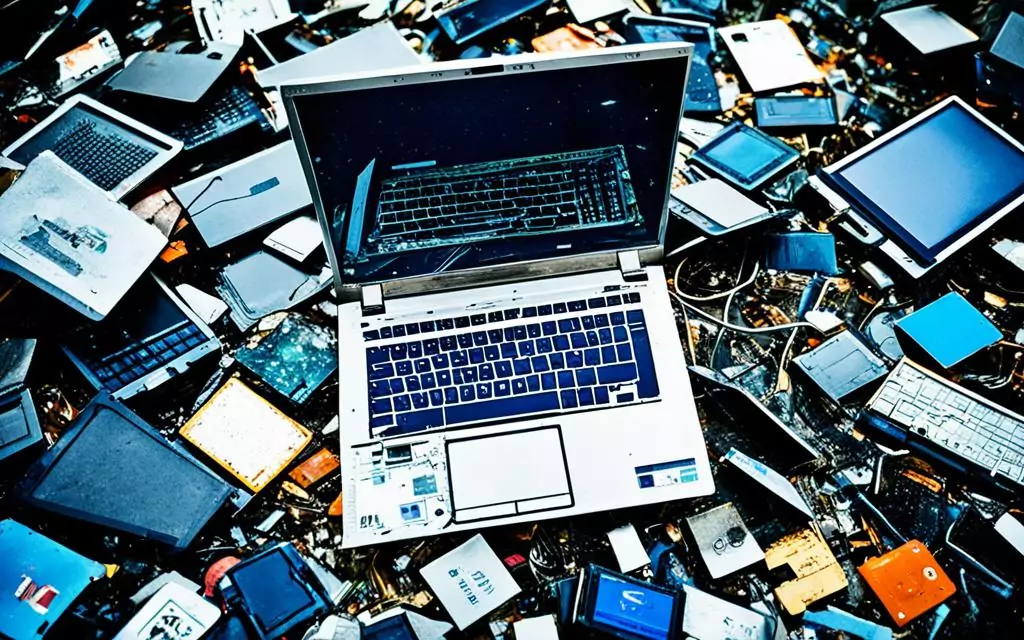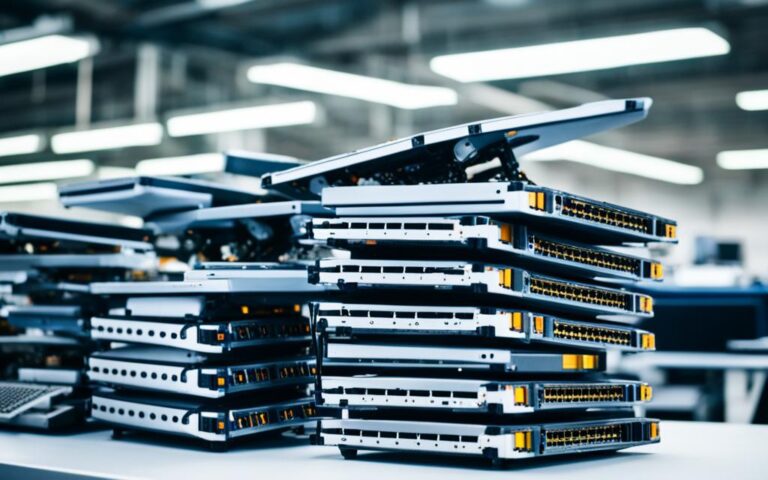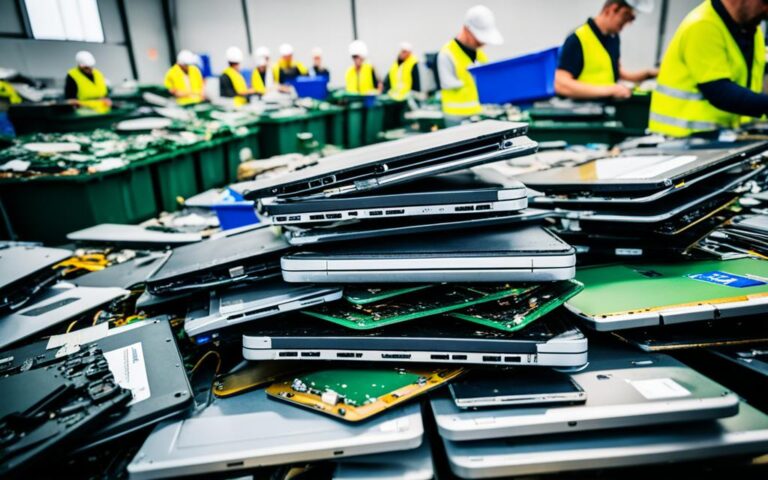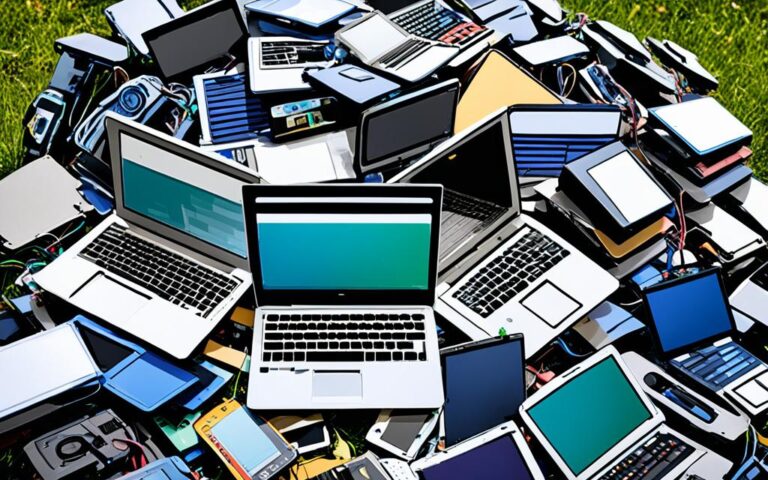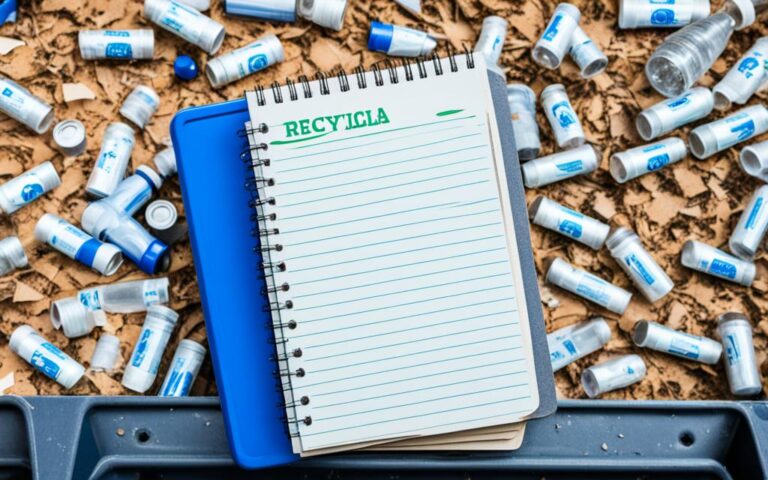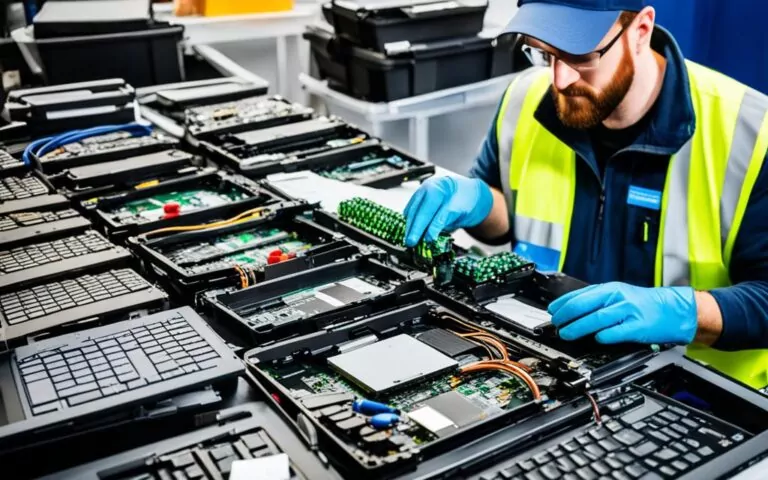The Many Lives of a Recycled Laptop: Reuse Options Explored
The growth of consumer electronics has led to an increase in electronic waste (e-waste) or Waste Electrical & Electronic Equipment (WEEE). This e-waste is predicted to grow by 21% by 2018. Reuse has been identified as the most appropriate end-of-life strategy for suitable electronics, as it extends the product’s lifetime and offsets the embodied energy created during manufacturing.
Reuse and product lifetime extension models are part of the Circular Economy, which aims to promote efficient use of resources and a green economy. Critical raw materials present in e-waste are currently not being recycled or recovered. Reuse has important social aspects, such as job creation and benefits for low-income families.
The Circular Economy also includes methods like remanufacturing, repair, refurbishment, and repurposing. Repurposing is the identification of a new use for a product that can no longer be used in its original form, and it offers opportunities for innovation in design. Repurposing and reuse enable product lifetime extension and reduced reliance on primary production.
The research presented in this paper aims to explore the feasibility of repurposing suitable parts from end-of-life notebook computers, sourcing these computers from consumer WEEE, developing a methodology to inspect and validate the suitability of these parts, and establishing eco-design criteria for repurposing notebook computers as thin client computers. Repurposing notebook computers allows for the disassembly of all components and the recovery of materials such as critical raw materials and components with a large embodied energy. The research also addresses potential environmental, economic, and societal benefits of repurposing notebook computers.
The Environmental Impact of E-Waste and the Need for Laptop Reuse
The growth of consumer electronics has resulted in a significant increase in electronic waste or Waste Electrical & Electronic Equipment (WEEE). It is predicted that e-waste will grow by 21% by 2018. The United Nations Environment Program (UNEP) and the European Union (EU) have identified resource efficiency and the Circular Economy as key objectives to protect the environment and promote a green economy. E-waste is a complex waste stream with diverse materials, including precious metals and plastics. Critical raw materials present in e-waste, such as cobalt, neodymium, indium, and tantalum, are not being recycled or recovered.
Reuse has been identified as the most appropriate end-of-life strategy for suitable electronics, as it extends the product’s lifetime and offsets the embodied energy created during manufacturing. Reuse also has important social aspects, such as job creation and prosperity for low-income families. The Circular Economy includes methods like remanufacturing, repair, refurbishment, and repurposing, which contribute to resource efficiency and the reduction of environmental impact.
The Environmental Impact of E-Waste
The improper disposal of e-waste poses significant environmental risks. When not recycled or recovered, e-waste contaminates soil, waterways, and air. The leaching of hazardous substances into the environment can have detrimental effects on ecosystems and human health. Furthermore, the extraction and processing of raw materials for electronics contribute to deforestation, habitat destruction, and increased greenhouse gas emissions. Addressing the environmental impact of e-waste requires effective strategies for reducing, reusing, and recycling electronic devices.
The Need for Laptop Reuse
“Laptop reuse plays a crucial role in mitigating the environmental impact of e-waste by extending the lifespan of electronic devices.”
Laptop reuse is an essential component of sustainable waste management. By giving laptops a second life through reuse, the demand for new devices is reduced, thereby conserving valuable resources and minimizing the environmental impact associated with manufacturing. Reuse also prevents electronic devices from ending up in landfills, where they can release toxic substances and pollute the surrounding environment. Implementing laptop reuse programs ensures that viable devices are redirected to those who can benefit from them, contributing to resource efficiency and the circular economy.
The Benefits of Laptop Reuse
Laptop reuse offers numerous benefits, including:
- Reduced Environmental Impact: Reusing laptops reduces the need for new production, conserving natural resources and minimizing greenhouse gas emissions.
- Resource Efficiency: Reusing laptops extends the lifespan of these devices, maximizing the value extracted from the raw materials used in their production.
- Social and Economic Benefits: Laptop reuse programs create job opportunities, support digital inclusion, and provide affordable access to technology, particularly for low-income communities.
- Health and Safety: Properly refurbishing and reconditioning laptops ensures they are safe to use, eliminating health risks associated with hazardous materials.
The Challenges of Laptop Reuse
While laptop reuse offers significant benefits, it also faces certain challenges, including:
- Hardware Specifications: Ensuring that reused laptops meet current hardware requirements may be a challenge, as technology rapidly advances.
- Market Demand: Establishing a market for reused laptops is essential to sustain laptop reuse programs and encourage their adoption.
- Cosmetic Condition: The physical appearance of reused laptops, including scratches or cosmetic wear, can impact their marketability and acceptability to users.
- Repair and Reconditioning: Laptop reuse often requires repair and reconditioning to ensure optimal performance and reliability, adding costs and time to the process.
Overcoming these challenges requires collaboration among stakeholders, including manufacturers, recyclers, refurbishers, and consumers, to establish standardized processes and support the growth of laptop reuse initiatives.
The Role of Repurposing in Laptop Reuse
“Repurposing enables the identification of new uses for end-of-life laptops, further extending their usefulness and reducing electronic waste.”
Repurposing is a key aspect of laptop reuse, allowing for the adaptation and use of laptop components in new applications. By repurposing individual laptop parts, such as LCD screens or processors, they can find new life in various industries and settings. Repurposing contributes to resource efficiency by maximizing the value extracted from laptops and reducing reliance on primary production.
| Benefit | Impact |
|---|---|
| Extended Product Lifespan | Reduces the need for new laptop production, conserving resources and minimizing environmental impact. |
| Resource Efficiency | Maximizes the value extracted from laptop components by repurposing them for new applications. |
| Job Creation | Supports employment opportunities in the refurbishment and repurposing sector. |
| Reduced E-Waste | Prevents laptops from ending up in landfills, reducing environmental pollution and health hazards. |
The repurposing of laptops offers a sustainable solution for extending their lifespan, reducing e-waste, and maximizing the value derived from these devices.
The Benefits and Challenges of Laptop Reuse
Laptop reuse offers several benefits to individuals and the environment. By extending the product’s lifetime, laptop reuse helps to reduce electronic waste and the associated environmental impact. Reusing laptops also contributes to resource efficiency by maximizing the use of existing materials and minimizing the need for new production. Additionally, laptop reuse can have positive social implications, such as creating job opportunities and providing affordable technology options for low-income families.
However, laptop reuse also presents a set of challenges that need to be addressed. One challenge is ensuring that reused laptops meet the current hardware specifications and performance requirements. Reused laptops may require upgrades or modifications to align with the latest software and technological advancements. Additionally, the availability of a market for reused laptops is crucial for the sustainability of the reuse model. Without a demand for these products, laptop reuse efforts may face limited success.
Furthermore, the cosmetic condition of the reused laptops can also pose challenges. To make laptops attractive to potential users, cosmetic repairs or refurbishment may be necessary. This can add to the overall cost and effort involved in the reuse process. Another challenge lies in the need for proper repair and reconditioning before laptops can be reused. Thorough inspection and testing are essential to ensure that reused laptops are functional and reliable.
To support laptop reuse initiatives, different business models have been developed. These models aim to address the challenges and maximize the benefits of laptop reuse. They often involve partnerships between organizations, refurbishment centers, and end-users. However, barriers such as lack of awareness, limited funding, and complex logistics can hinder the implementation and scalability of these models.
To sum up, laptop reuse offers significant benefits in terms of extending product life, reducing environmental impact, and promoting resource efficiency. However, it also presents challenges related to hardware specifications, market availability, cosmetic condition, and necessary repairs. By addressing these challenges and adopting suitable business models, laptop reuse can be a sustainable and impactful approach to managing electronic waste and promoting a circular economy.
Repurposing and the Potential of Laptop Reuse
Repurposing offers a wealth of potential when it comes to laptop reuse. It involves identifying a new use for a product that can no longer be used in its original form. The beauty of repurposing lies in its ability to foster innovation in design and overcome the challenges associated with the singular nature of electronics.
When it comes to laptops, repurposing can involve utilizing components from end-of-life notebook computers in new applications. For example, LCD screens can be repurposed as televisions, and smartphones can find new life as parking meters. These creative solutions not only give these devices a second chance but also contribute to resource efficiency by allowing the recovery of critical raw materials and the separation of components.
Furthermore, repurposing enables the extended use of parts and components, reducing the reliance on primary production. By giving new purpose to components that would otherwise go to waste, repurposing supports the circular economy and the principles of sustainability.
The potential of laptop repurposing extends beyond environmental benefits. It also has a significant impact on the economy and society as a whole. The repurposing of notebook computers sourced from consumer WEEE (Waste Electrical & Electronic Equipment) offers a hybrid end-of-life strategy that combines reuse and recycling. This approach allows for the selective reuse of certain components while recycling parts that contain high quantities of critical raw materials.
Ultimately, repurposing and laptop reuse present a win-win scenario. They not only provide a sustainable solution for managing electronic waste but also offer economic opportunities and social benefits. By exploring the potential of repurposing, we can unlock the value of discarded laptops and make a positive impact on the environment, economy, and society as a whole.
Repurposing and reuse can transform laptops from e-waste into valuable resources, mitigating environmental impact and promoting resource efficiency. As we delve deeper into the possibilities of laptop repurposing, we can explore new avenues that contribute to a greener future.
The Feasibility and Impacts of Laptop Repurposing
Repurposing end-of-life notebook computers to give them a new lease on life depends on several factors. The feasibility of this process largely hinges on the working condition of the system boards, processors, and memory modules. Additionally, the architecture and design of the system board must be suitable for reuse in a new housing.
By repurposing and extending the use of components, we can achieve resource efficiency and reduce the environmental impact of electronic waste. Repurposing allows us to recover critical raw materials and offset the embodied energy from manufacturing. It also provides a valuable source of parts for the repair industry, helping to offset the cost of manual disassembly.
The repurposing of notebook computers as thin client computers presents an exciting opportunity to further reduce environmental impact and increase energy efficiency. By repurposing laptops in this manner, we can optimize their use and minimize waste.
To evaluate the feasibility and impacts of laptop repurposing, a life cycle assessment (LCA) can be conducted. This assessment involves analyzing the entire life cycle of refurbished laptops, comparing their carbon handprint to that of new laptops. This analysis provides valuable insights into the environmental benefits of repurposing and underscores the importance of this practice in a circular economy.
Key Impacts of Laptop Repurposing
- Resource Efficiency: Repurposing enables the recovery of critical raw materials and reduces reliance on primary production.
- Environmental Impact: By offsetting the embodied energy from manufacturing and reducing e-waste, laptop repurposing helps protect the environment.
- Cost Reduction: Repurposing provides a cost-effective source of parts for the repair industry and reduces the expenses associated with manual disassembly.
- Energy Efficiency: Repurposed laptops, especially those used as thin client computers, can contribute to energy savings and increased efficiency.
- Social Benefits: Laptop repurposing supports job creation and offers opportunities for low-income families to access affordable technology.
| Impact Area | Description |
|---|---|
| Resource Efficiency | Reduces dependence on primary production by repurposing existing laptop components. |
| Environmental Impact | Reduces e-waste and offsets the embodied energy from manufacturing. |
| Cost Reduction | Provides a cost-effective source of parts for repairs and reduces manual disassembly expenses. |
| Energy Efficiency | Contributes to energy savings and increased efficiency, especially when repurposing laptops as thin client computers. |
| Social Benefits | Supports job creation and provides affordable technology options for low-income families. |
Conclusion
Laptop reuse, particularly through repurposing, offers significant opportunities to extend the lifetime of electronic devices, reduce environmental impact, and promote resource efficiency. The growth of consumer electronics and the resulting increase in electronic waste (e-waste) highlights the need for effective strategies to manage, dispose of, and recycle electronic devices. Reuse, including repurposing, has been identified as the most appropriate end-of-life strategy for suitable electronics. It not only extends the product’s lifetime but also offsets the embodied energy created during manufacturing.
The Circular Economy, with its focus on reuse and recycling, provides a framework for promoting resource efficiency and a green economy. By repurposing notebook computers sourced from consumer WEEE, we can contribute to the recovery of critical raw materials and the reduction of environmental impact. Through repurposing and reuse, the potential of laptop reuse can be realized, leading to environmental, economic, and societal benefits.
In conclusion, the repurposing of laptops is a viable solution that not only helps tackle the growing issue of e-waste but also contributes to resource efficiency and sustainability. By extending the lifespan of laptops through repurposing, we can reduce the need for new electronic devices and minimize the environmental impact associated with their manufacturing and disposal. Furthermore, laptop reuse allows for the recovery of valuable materials, promoting a circular economy and reducing reliance on primary production. Embracing laptop reuse as a key strategy can lead us in creating a greener, more sustainable future.
FAQ
What is the environmental impact of e-waste?
E-waste, or electronic waste, has a significant environmental impact. Improper disposal of electronics leads to pollution and the release of toxic substances into the environment. E-waste also contributes to resource depletion and energy consumption associated with the manufacturing of new devices.
Why is laptop reuse important?
Laptop reuse is important because it extends the product’s lifetime and offsets the energy and resources used in manufacturing new laptops. It also reduces the amount of e-waste that ends up in landfills and provides economic and social benefits.
What are the benefits of laptop reuse?
Laptop reuse offers several benefits, including the extension of the product’s lifetime, the reduction of environmental impact, and the promotion of resource efficiency. It also has important social aspects, such as job creation and prosperity for low-income families.
What are the challenges associated with laptop reuse?
Laptop reuse faces challenges such as the need for suitable hardware specifications, availability of a market for reused products, and the cosmetic condition of the unit. Repair or reconditioning may be required before a laptop can be reused.
What is repurposing and how does it relate to laptop reuse?
Repurposing is the identification of a new use for a product that can no longer be used in its original form. In the context of laptop reuse, repurposing involves using components from end-of-life laptops in new applications. It can contribute to resource efficiency, the recovery of critical raw materials, and the reduction of environmental impact.
What is the feasibility of repurposing laptop parts?
The feasibility of repurposing laptop parts depends on factors such as the working condition of the components and the suitability of the system board for reuse in a new housing. Repurposing allows for the recovery of critical raw materials and the offset of embodied energy from manufacturing.

